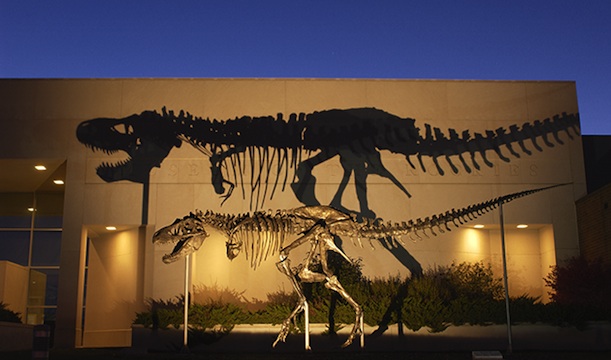Due to the Shutdown, Arrival of the Natural History Museum’s T. Rex is Postponed Until Spring
The highly anticipated acquisition of one the most complete T. Rex specimens in existence is delayed
/https://tf-cmsv2-smithsonianmag-media.s3.amazonaws.com/filer/20131004121047TRex-NMNH-Big-Mike-2-copy.jpg)
In June, the Natural History Museum announced one of its most significant acquisitions in some time: one of the most complete Tyrannosaurus rex specimens in existence, a fossil known as “Wankel’s Rex,” on a 50-year loan from the Museum of the Rockies in Bozeman, Montana. The 38-foot-long, 7-ton skeleton was set to be shipped from Bozeman on October 11 and complete its cross-country trip on October 16, arriving amidst celebrations for National Fossil Day on the National Mall.
Today, after much speculation, the museum officially announced that the T. rex‘s journey will be postponed due to the shutdown of the federal government. New plans call for the specimen to arrive sometime during April. “It’s a major specimen, so we’re being very prudent about how we handle it,” said Kirk Johnson, the museum’s director. ”There’s a lot of uncertainty with the shutdown, and uncertain availability of federal workers to do the work that we need to do.”
The decision to push back the highly anticipated shipment all the way until spring was also influenced by weather concerns. “There’s an early winter storm that’s in the Rockies right now. We’d been hoping to get the thing moved before winter came, so now we’ll have to wait until winter has passed,” Johnson said. “There aren’t too many T. rex skeletons around, so you want to take care of the ones that you have.”
When the specimen was discovered in 1988 by an amateur fossil hunter named Kathy Wankel on the Fort Peck Reservoir in Montana, it was the most complete T. rex in existence—roughly 85 percent intact, in total—and included the first ever T. rex forearm bones ever found. Plans call for the fossil to serve as the centerpiece of the of the museum’s new Dinosaur Hall when it opens in 2019, with a series of temporary exhibits that feature parts of the skeleton and digital renderings on display in the meantime.
Smithsonian researchers will also continue study on the specimen. Staff from the 3D Lab in the Smithsonian’s Digitization Program Office—who’ve already pioneered the digitization of many scientific specimens, from fossilized whales excavated in Chile to many of the skeletons that currently fill the museum’s Dinosaur Hall—plan to create digital renderings of the T. rex‘s bones, so that researchers can print replicas of the fossil at any scale and study them in a virtual environment.
In due time, Wankel’s Rex will still fuel these research and educational roles—but for now, the shutdown means all plans are on hold. The arrival festivities timed to coincide with National Fossil Day, a celebration organized by the National Park Service, however, will be permanently cancelled, as the event will have to go on without the T. rex. “It would have been nice to deputize those 600 kids on the Mall as junior paleontologists,” Johnson said.
The postponement comes four days into the federal shutdown, which has closed the Natural History Museum, along with all Smithsonian facilities. “As the most visited museum in the U.S., we’re eager to open our doors as soon as possible for all visitors,” said Ryan Lavery, a spokesman for the museum.
Typically, the museum is visited by roughly 7.6 million people per year, or 20,000 per day, free of charge. “The majority of our staff is furloughed right now, so all the work that we do is being postponed as we wait for the government to open,” said Johnson. “We have tens of thousands of visitors every day who want to come to the museum, and right now they aren’t able to access it.”
/https://tf-cmsv2-smithsonianmag-media.s3.amazonaws.com/accounts/headshot/joseph-stromberg-240.jpg)

/https://tf-cmsv2-smithsonianmag-media.s3.amazonaws.com/accounts/headshot/joseph-stromberg-240.jpg)